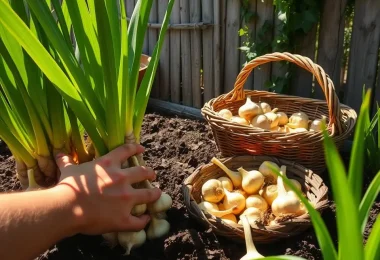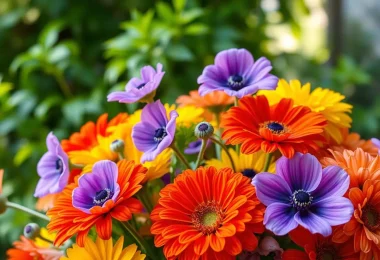Persicaria is a vibrant and versatile addition to any garden. This guide will help you grow these captivating plants successfully. We’ll cover everything from choosing the right spot to caring for your Persicaria. You’ll learn how to achieve beautiful blooms and a lush garden.

Key Takeaways
- Persicaria is a diverse genus with a range of varieties to choose from
- Selecting the right location with the appropriate soil conditions is crucial for optimal growth
- Proper planting techniques and ongoing care ensure the health and longevity of your Persicaria plants
- Persicaria can be incorporated into various garden designs, adding a pop of colour and texture
- Overwintering and propagation methods allow you to maintain and expand your Persicaria collection
related: How to Plant and Care for Hyacinths: A Step-by-Step Guide
Introducing Persicaria: A Vibrant Addition to Your Garden
Persicaria, also known as knotweed or smartweed, is a stunning choice for gardens. These perennials come in a variety of colours and shapes. They add elegance to any outdoor area.
Unveiling the Beauty of Persicaria
Persicaria plants are famous for their bright, eye-catching flowers. They range from deep red to soft pink and white. Their tall flower spikes add a striking vertical element to gardens.
Diverse Varieties: Exploring the Persicaria Family
The Persicaria family includes many different types of plants. You can find classic red-tipped varieties and unique ones like ‘Firedance’ and ‘Uperba’. There’s a Persicaria for every gardener’s taste.
Looking for a bold statement plant or something more subtle? Persicaria has plenty of options. They can make your garden look even more beautiful.
“Persicaria plants are a true delight, bringing vibrant colour and architectural interest to any garden.”
Choosing the Perfect Spot for Your Persicaria Plants
When growing persicaria, picking the right spot is key. This vibrant plant does best in the right conditions. By considering a few important factors, your persicaria can thrive in your gardening space.
Sunlight is a big factor. Persicaria loves full sun, needing at least six hours a day. But in very hot places, some shade helps to stop leaves from burning.
Soil type matters too. Persicaria does well in soil that drains well and is rich in nutrients. Don’t plant them in heavy clay or wet areas. Instead, choose a spot with loamy, slightly acidic soil that holds moisture but doesn’t get too wet.
- Ensure the soil is well-draining to prevent waterlogging
- Choose a spot with nutrient-rich, slightly acidic soil
- Provide the plants with at least six hours of direct sunlight per day
By thinking about these factors, you can make a great home for your persicaria plants. They’ll add a burst of colour to your gardening area.

“Choosing the right spot is the foundation for successful persicaria cultivation. Pay attention to the soil, sunlight, and drainage, and you’ll be rewarded with a stunning display of colour throughout the seasons.”
Preparing the Soil for Optimal Growth
To start a vibrant Persicaria garden, you need to prepare the soil. Healthy, nutrient-rich soil is key for your plants to grow well. We’ll explore how to understand your soil’s pH and nutrient needs. We’ll also cover the best ways to amend it for your Persicaria.
Understanding Soil pH and Nutrient Requirements
Persicaria plants do best in slightly acidic to neutral soil, with a pH of 6.0 to 7.0. Use a simple testing kit to check your soil’s pH. If it’s too high or low, you can adjust it with sulphur or lime.
Persicaria also needs nutrient-rich soil. Test your soil for nitrogen, phosphorus, and potassium. Add compost or well-rotted manure to make the soil more fertile.
Amending the Soil: Tips and Techniques
- Add 2-4 inches of compost or well-rotted manure to the top 8-12 inches of soil. This improves drainage, aeration, and nutrient content.
- If your soil is heavy and clay-like, mix in sand or perlite. This helps with drainage and makes the soil easier to work with.
- For sandy soils, add organic matter. This helps keep moisture and nutrients in the soil.
- Use a balanced, slow-release fertiliser. It provides nutrients steadily throughout the growing season.
By preparing and amending your soil well, you’ll give your Persicaria plants the best chance to thrive. They’ll grow vibrant and healthy.

Persicaria: Planting Techniques for Success
Getting your Persicaria planted right is crucial for a lively garden. This guide will help you pick the best time and follow a simple planting process. You’ll learn how to make sure your Persicaria plants grow well.
When to Plant Persicaria
The best time to plant Persicaria is in spring or early autumn. This lets the plants grow strong before the busy season or winter. Plant when the soil is damp but not soggy, and the weather is mild, around 15-25°C.
Step-by-Step Planting Guide
- Choose a spot that gets some sun to full sun and drains well.
- Make the soil better by adding compost or manure to help it grow and drain.
- Dig a hole that’s a bit bigger than the plant’s roots.
- Take the plant out of its pot carefully to avoid harming the roots.
- Put the plant in the hole, making sure the crown is even with the soil.
- Fill the hole with the soil mix, pressing it down to get rid of air pockets.
- Water the plant well to help it settle and start growing roots.
- Put organic mulch around the plant to keep moisture in and weeds out.
By following these easy steps, you’ll have a Persicaria garden that’s full of life and colour.

Caring for Your Persicaria Garden
Looking after a persicaria garden needs careful attention. It’s important to know how much water your plants need. This helps keep them healthy and looking great all season.
Watering Needs and Best Practices
Persicaria plants love water and need it often. Make sure to water them regularly. The soil should be moist but not too wet.
When you water, focus on the soil around the plants. Avoid getting the leaves wet to stop diseases. Watering in the morning or evening helps the plants soak up the water better.
- Water persicaria plants regularly, keeping the soil moist but not waterlogged.
- Concentrate the water around the base of the plants, avoiding wetting the foliage.
- Water in the early morning or evening to minimise evaporation and maximise absorption.
- Monitor soil moisture and adjust watering frequency as needed, especially during hot, dry periods.
| Watering Requirement | Soil Condition | Watering Frequency |
|---|---|---|
| High | Consistently moist | Daily or every other day |
| Moderate | Evenly moist | 2-3 times per week |
| Low | Slightly dry between waterings | Once a week |
By following these tips, your persicaria garden will get the right amount of water. This will help it grow well and show off beautiful flowers.
Pruning and Maintenance: Keep Your Persicaria Looking Its Best
Keeping your persicaria plants healthy and looking good is key for a lively garden. The right pruning and care can make your persicaria plants flourish. They will keep surprising you with their beautiful flowers. Here are the main steps to keep your persicaria garden in top shape.
Optimal Pruning Timing
When to prune your persicaria is very important. The best time is early spring, when new growth starts. This helps the plants grow strong and healthy.
Pruning Techniques
- Deadhead spent flowers: Remove any old or faded flowers to make the plant bloom more.
- Trim back foliage: Cut back any long or messy leaves to keep the plant neat.
- Shape and thin: Use shears to shape the plant and remove any crowded stems. This improves air flow.
Ongoing Maintenance
- Weed control: Keep weeds away from your persicaria to stop them from taking nutrients and water.
- Mulching: Put a 2-3 inch layer of organic mulch around the plants. It keeps moisture in and weeds out.
- Fertilising: Give your persicaria a balanced, slow-release fertiliser in spring. It helps them grow well.
By sticking to these pruning and care tips, your persicaria plants will stay healthy and beautiful. A bit of effort will make your gardening space a stunning place for years.

Persicaria in Bloom: Enjoying the Vibrant Flowers
See the beauty of Persicaria as it bursts into colour. These flowers make any garden stand out. They change the look of your garden with their bright colours and lively presence.
Encouraging Prolific Blooming
To get your Persicaria to bloom more, try these tips:
- Give them lots of sunlight: Persicaria loves full sun. Make sure they get at least 6 hours of direct sunlight every day.
- Keep the soil moist but not soggy: Persicaria likes moist, well-drained soil. Add organic matter to help with this.
- Remove old flowers: Take off faded blooms to make the plant grow more flowers.
- Fertilise often: Use a balanced, slow-release fertiliser in early spring. It helps with growth and lots of flowers.
By doing these simple things, you can have a garden full of persicaria flowers. They add colour and beauty to your outdoor area.

“Persicaria is a true showstopper in the garden, with its captivating blooms that seem to dance in the breeze.”
Adding persicaria to your garden design can make it look better. It brings natural beauty to your outdoor space.
Incorporating Persicaria into Garden Design
Persicaria is a vibrant and versatile perennial plant. It can add colour and texture to your garden. By choosing the right plants to go with Persicaria, you can make your garden look stunning.
Companion Planting Ideas
Persicaria looks great with plants that grow well together. Here are some good choices for your garden:
- Grasses: Ornamental grasses like Miscanthus or Panicum add height and contrast to Persicaria.
- Perennials: Echinaceae, Helenium, or Rudbeckia can add a pop of colour next to Persicaria.
- Shrubs: Low-growing shrubs like Lavandula or Thymus offer a nice contrast in texture and height.
Persicaria as a Focal Point or Border Plant
Persicaria’s foliage and flowers are eye-catching. They’re perfect for making a focal point or defining garden borders. Here are some ideas:
- Focal Point: Place Persicaria alone to draw attention and create a beautiful garden centre.
- Border Planting: Mix Persicaria with other plants and grasses for a layered, interesting border.
- Cascading Displays: Let Persicaria spill over walls or beds for a natural, flowing look.
Adding Persicaria to your garden can make it more interesting and cohesive. It creates a beautiful and harmonious outdoor space.
Overwintering and Propagating Persicaria
Keeping your Persicaria plants alive through winter is key. With the right care, you can enjoy their beautiful flowers for many years. As winter gets closer, it’s important to prepare your Persicaria. This protects them from cold weather and keeps them healthy.
To keep your Persicaria safe, give them a warm place like a greenhouse or a sheltered spot in your garden. Mulching around the plants helps keep their roots warm and moist. You might also need to cut back the leaves to the ground. This helps the plants save energy for growing strong roots next year.
Propagating Persicaria is a great way to grow more plants and share them with others. You can use cuttings or divide the rhizomes to multiply your plants. By following the right steps, you can grow new Persicaria plants. This means you’ll have more beautiful flowers to enjoy for years.
FAQ
What is Persicaria, and how can it enhance my garden?
Persicaria, also known as knotweed or smartweed, adds colour to gardens. It comes in many varieties, from classic red-tipped to unusual ones. This makes it a great choice for any garden.
What are the key factors to consider when choosing a location for Persicaria plants?
Choosing the right spot is key for Persicaria plants to grow well. Think about sunlight, soil type, and drainage. They like well-drained, rich soil and some sun.
How do I prepare the soil for optimal Persicaria growth?
Good soil is essential for Persicaria. Check your soil’s pH and nutrients. Add compost or manure to improve it and give your plants what they need.
When is the best time to plant Persicaria, and what is the step-by-step planting process?
Plant Persicaria in spring or autumn when the soil is moist. Follow a guide to pick the right plants, space them, and plant them. This makes planting easy and successful.
How do I care for my Persicaria plants, and what are the best watering practices?
Caring for Persicaria needs attention. Make sure they get the right amount of water. They like moist but drained soil. Water them regularly, adjusting as the weather and plants change.
When and how should I prune and maintain my Persicaria plants?
Pruning and maintenance are important for Persicaria. Trim, deadhead, and manage your garden at the right times. This encourages growth and more blooms.
How can I encourage prolific blooming in my Persicaria plants?
For more blooms, focus on the right growing conditions. Ensure they get enough sunlight and have rich soil. Also, deadhead spent flowers to encourage more blooms.
What are some effective ways to incorporate Persicaria into my garden design?
Persicaria fits well into garden designs. Use companion plants to enhance its beauty. Or place them as focal points or in stunning borders.
How do I properly overwinter and propagate my Persicaria plants?
To keep your Persicaria plants long-term, overwinter and propagate them well. Protect them in cold months and multiply them through division or other methods. This will give you more blooms in the future.









